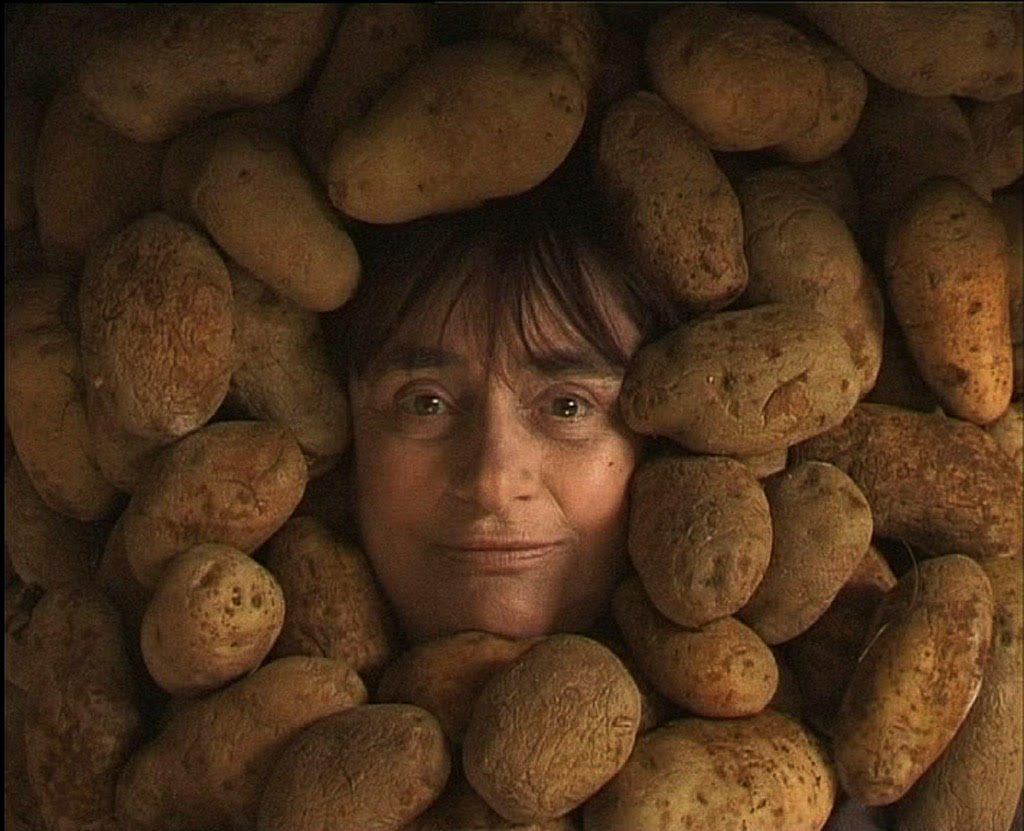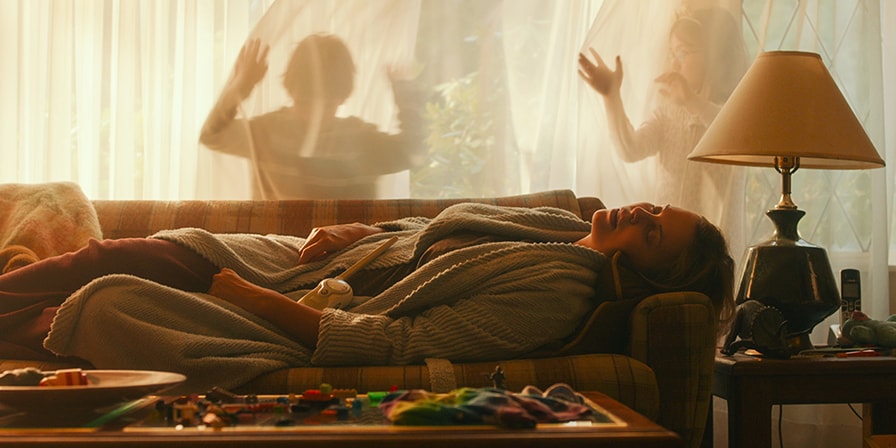“Maybe it’s a mirror”: Varda and Birkin in 1987
By Matt Hoffman | 14.02.2021
Jane B. Par Agnès V. Dir. Agnès Varda. 1988.
In 2016, I was offered the opportunity to interview Agnès Varda. The interview was to be tied to the Blu-Ray release of Varda’s 1988 films Kung-Fu Master! and Jane B. Par Agnès V. At the time, I had seen only one of Varda’s films, the French New Wave masterwork Cléo de 5 à 7 (1962). Nevertheless, I jumped at the opportunity to interview the iconic filmmaker. The interview was scheduled for a Friday afternoon. Varda was to call me from her home in Paris. The day before the interview, I received an email asking if we could reschedule to the following Monday; not a problem, of course. On Sunday, the dreaded email came notifying me that “Agnès could not be reached.” The fated Monday approached, and still, no word from Varda or her team. I had watched Kung-Fu Master! (Henceforth referred to as Le Petit Amour) in preparation, but had not watched Jane B. par Agnès V. by that time. Years passed and since then I was not offered another interview with Varda. That being said, I did manage to address my Agnès Varda “blindspot” and have seen twenty-four of her films (features and shorts combined). Yet, one piece managed to escape me, even though it had been on my Blu-Ray shelf, in plain sight for years. Thus, when the opportunity arose to write about one of Varda’s films as part of a tribute to the filmmaker, I decided to avoid my favourites; to look past films that have deeply affected me such as The Gleaners and I (2000), The Beaches of Agnès (2008), or Le Bonheur (1965). Instead, the long delayed task of watching Jane B. par Agnès V., and revisiting its partner Le Petit Amour seemed the appropriate course.
***
In 1986, Agnès Varda met with French actress/model/singer/icon Jane Birkin to discuss Varda’s most recent film, Vagabond (1985). After attending a screening of the film with her daughter Charlotte Gainsbourg, Birkin found herself moved to write to Varda in appreciation. Varda, charmingly, was unable to read Birkin’s handwriting and proposed that the two meet in person to discuss the film. It was at this meeting that Varda proposed the idea that she direct a biographical portrait of Birkin. Months later, the two were at work on Jane B. par Agnès V. Though neither of them knew it at the moment, the journey of shooting their documentary would incite the production of another collaboration, the fictional film Le Petit Amour (released internationally under the bewildering title Kung-Fu Master!). Both Jane B. par Agnès V. and Le Petit Amour — one a documentary, the other a narrative drama — challenge the concept of autobiographical truth with disruptions of the gaze. The result is two tales that provide as many solutions as they provoke queries, leaving the viewer feeling closer to Birkin the icon, while simultaneously pushed further away from Birkin the mortal.
“Look at the camera as much as you can…if not you won’t be looking at me,” instructs Varda to Jane Birkin at the beginning of her film Jane B. par Agnès V. The reluctant Birkin expresses her fears of the camera and the subjectivity held by her instructor. It is not the camera so much that Birkin fears, but the director herself. She replies, “What counts is the eye behind the camera, the person holding the paintbrush…I don't care what you do to me, as long as I feel you like me.” Up to this point, Birkin’s public image has been one where the paintbrush was held by another — often a man — yet, this impending journey with Varda promises one in which the two can author her portrait together. Birkin first gained notoriety in 1966, following a brief appearance in Michelangelo Antonioni’s Blow-up (1966). In the late sixties, she met Serge Gainsbourg, the French chanteur whom she would marry and collaborate with through the 1970s. Birkin was fixed behind Gainsbourg, her words, back-up vocals, and body pushed meters into the background in their 1970 music video for “Je t’aime”. Alongside Varda, Birkin will write her own scenes, tell her own story, and meditate on becoming an “old woman” at forty years of age. Nearly twenty years her senior, Varda playfully scoffs at Birkin’s assertion that forty is old.
Varda calms Birkin’s fear of the camera’s intimacy by explaining to Birkin that the camera is like a mirror. The camera's function is dual: both literally and figuratively representing a mirror. “No,” Birkin retorts, “You don’t look at others in a mirror, you look at yourself.” The scene cuts to Birkin in a forest standing in front of a floating mirror. Varda defends her statement via voiceover, saying, “Exactly. I’m filming your self-portrait. But you won’t be alone in the mirror. There will be the camera, it’s a bit me. Too bad if I appear in the mirror or the background.” Varda seems to insert herself into the frame to comfort Birkin, enacting what would be the beginning of a new, self-reflexive style of filmmaking for Varda.
In her book Gendered Frames, Embodied Cameras, Cybelle H. McFadden writes, “the intersection of the portrait and the mirror not only illustrates an important mise en abyme of the artist’s creative act, but it establishes a significant intertextuality between painting and filmmaking and highlights the process of image formation” (51). This “mise en abyme” (the notion of inserting a story within a story) is one that Varda would continue for the rest of her career. It is Jane B. par Agnès V. that first introduces Varda as a character within her own films. She would continue this in some of her most celebrated work, including The Beaches of Agnès, The Gleaners and I, and most recently in the Oscar-nominated Faces Places. Varda is thus no mere director, but a subject herself, allowing her audience unique access to her view of modern society.
In playing the dual role of filmmaker and subject, Varda invites Birkin to join her role-playing exercises. Through a series of vignettes spread throughout the film, Birkin abandons her surname to inhabit the figures of other notorious Janes in film history. She becomes Jane of Tarzan, Jeanne d’Arc, Calamity Jane—all by her own accord. Varda also casts her as Oliver Hardy (in a short Laurel and Hardy tribute), an old woman reflecting on the inevitable death of her dog, and, much to Birkin’s frustration, a Spanish flamenco dancer. What is perhaps the most difficult role comes from Birkin herself: a mother who falls in love with the teenaged friend of her daughter’s. Birkin proposes the scenario to Varda, explaining that the idea is based on a strange attraction she had to a vomiting boy at her teenage daughter’s birthday party. Though in the midst of shooting, Varda chooses to explore this narrative as a separate entity in film Le Petit Amour.
Shot in the summer of 1986, when both Varda’s and Birkin’s children would be on vacation from school, Le Petit Amour casts Varda’s own son Mattieu Demy — fourteen at the time — as the young infatuate Julien. Birkin’s daughters Charlotte Gainsbourg and Lou Doillon play the daughters of Birkin’s Mary-Jane. Demy was reticent to offer his summer vacation to his mother’s work, but with some convincing from his father — the legendary Jacques Demy — and the promise that he could play video games as much as he wanted between takes. Demy was persuaded (Varda, 2015).
Mary-Jane’s attraction to the young Julien is immediate. There is a strange eroticism in the act of Mary-Jane holding the young man, who bends over a toilet sick from drinking. Mary-Jane instructs him to open his mouth so that she can help him vomit. He does. In these brief moments, Mary-Jane reaches her middle and index fingers deep into Julien’s throat, and the boy immediately vomits, suddenly feeling better. This is the sole penetrative act that occurs between the two on screen, yet the discussions of sex, or the kisses shared between the two leave its audience perplexed. How can we rationalize this pseudo-reverse-Lolita situation, as dealt by one of cinema’s most compassionate filmmakers?
Set in the late ‘80s, Le Petit Amour takes place during a time where the boundaries of love and sex have been capped. Gone is the “free love” movement from Mary-Jane’s youth. It has been replaced with a fear of AIDS, the “lover’s disease.” The impending AIDS crisis is situated throughout the film through advertisements and televisions. Years before Michael Haneke would replicate such a technique in many of his films, Caché in particular. The characters discuss the epidemic amongst themselves occasionally, but most of the discussion around AIDS plays out in the background of the frame, with dialogue from the television often masked by the characters’ own conversations. Mary-Jane is careful and tender while her object of desire is reckless and crude — he’s just a normal fourteen-year-old boy. The two kiss passionately on screen, a sight that causes the inevitable turning of the stomach. Nevertheless, when Julien suggests that Mary-Jane join him in his cousin’s hotel room, she achieves a surprising sense of repulsion.
After joining Julien at a hotel bar, Mary-Jane silently agrees to follow him upstairs to his “cousin’s room.” As the two squeeze themselves into a tiny elevator, Varda’s mirror returns. Pushed together by the sheer lack of space, Birkin stands with her back to a small mirror on the elevator’s wall. In the frame, we see two different Mary Janes, and two different Juliens. The Mary-Jane in the elevator seems to stare at Julien in disappointment. In this turn to the salacious — two people going up to a hotel room for the sole purpose of having sex — Julien seems to have shattered the ideal “pure love” represented by their unconsummated relationship. Julien, in turn, returns her gaze. No longer bleeding with confidence, Julien appears as the little boy he truly is, looking up at Mary-Jane, who holds the future of the evening in her hands. Confoundingly, and with no cinematic illusions at play, the Mary-Jane and Julien reflected in the mirror appear as others. In their reflection lives the lost gaze of desire. The two appear to stand closer together in the mirror, while their facial expressions appear softer, and with greater understanding of the other’s circumstance. Julien grabs Mary-Jane’s face to kiss her. In the mirror he appears inexperienced and with little confidence. Beside the mirror, Julien is forceful, seemingly knowing what he wants and how to get it. They do kiss passionately for a moment, yet the image of their mouths pressed together is visible only in their reflection. Suddenly, Mary-Jane snaps out of her lust, pushing the boy off of her and proclaiming, “I won’t go to a hotel room with you!” Julien, taken aback, calls her “crazy” before removing a cigarette from his pocket and lighting it. It is this motion that seems to reveal his true childishness to Mary-Jane. She is appalled that someone her daughter’s age would smoke and would have the nerve to do so in a small, cramped elevator. As he blows cigarette smoke in her face, Mary-Jane, repulsed, slaps the boy across the face; he returns the slap without hesitation. Ultimately, what do Varda and Birkin have to say about the pure love that the film questions? Perhaps, though not nihilistically, it is that purity in love simply cannot exist in the world we have created for ourselves.
If Varda’s goal in creating these two films was to humanize an iconic figure, she undoubtedly succeeds. Nevertheless, one cannot help but leave Jane B par. Agnès V. and/or Le Petit Amour feeling confounded by the image Birkin wishes to portray. Through her use of mirroring and costume, Varda creates a space for Birkin to explore her deepest artistic desires. Birkin, the auteur, is confronted by circumstance. She overflows with ideas, wit, and mystery. Perhaps, it is only for the achingly humane Varda that Birkin can create two portraits that thrive, challenge, and captivate.
Also Read
Click here for works cited in "“Maybe it’s a mirror”: Varda and Birkin in 1987"



